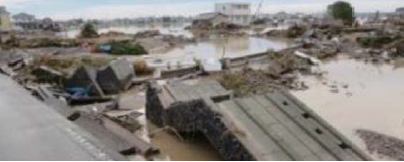- |
- Top
- |
- Points
- |
- Non-Structural Measures
- |
- Structural Measures
- |
- Communities
- |
- Japanese
- |


Large-scale flood is inevitable that exceeds the capacity of facilities.
|
In September 2015, torrential rains in the Kanto-Tohoku region caused a levee breach
along the Kinu River which led to extensive long-term inundation that destroyed and swept away houses
near the levee, and stranded many people. (photograph on right) Conventional flood control measures focused on improvement of river facilities to prevent outflow. However, we must now assume that large-scale floods beyond the capacity of the facilities are inevitable. River administrator will promote measures for flood risk reduction throughout our whole society to eliminate delays in evacuation and minimize economic loss even when such large-scale flooding occurs. |

|


Extensive and Long-term
Inundation
Inundation
Large areas, including residential zones, were submerged for an extended period.
40 km2, equivalent to one-third of Joso City in Ibaraki Prefecture, including 10,000 houses, were inundated.
It took around 10 days to drain the area.

Numerous Houses
Destroyed and Swept Away
Destroyed and Swept Away
Water flowed out of the breach and washed away many houses near the levee.

Many People Stranded and
Evacuees to other Cities
Evacuees to other Cities
A delayed evacuation advisory caused many people to be stranded,
including 4,300 residents who had to be rescued. Half of the 1,800 evacuees had to move to other cities.
The 2015 torrential rains in Kanto-Tohoku revealed that conventional policies and measures
were no longer sufficient against recent floods. Accordingly, on December 10th, 2015,
Minister of Land, Infrastructure, Transport and Tourism requested that
the chair of the Council for Social Infrastructure Development formulate a concept
regarding Flood Control Measures for Flood Disaster Risk Reduction against Large-Scale Inundation
and the following issues and challenges were identified.
Problems to be Solved
|
- Appropriate decisions and actions by each municipality and resident /
wide-area evacuation beyond boundaries of the municipalities
|
The reports compiled by the Council for Social Infrastructure Development
set out the basic policies for solving these issues: measures to be implemented promptly,
and measures to be examined promptly and realized in the near future.
Based on these, the Policy Vision on Rebuilding Flood-Conscious Societies was launched.
|